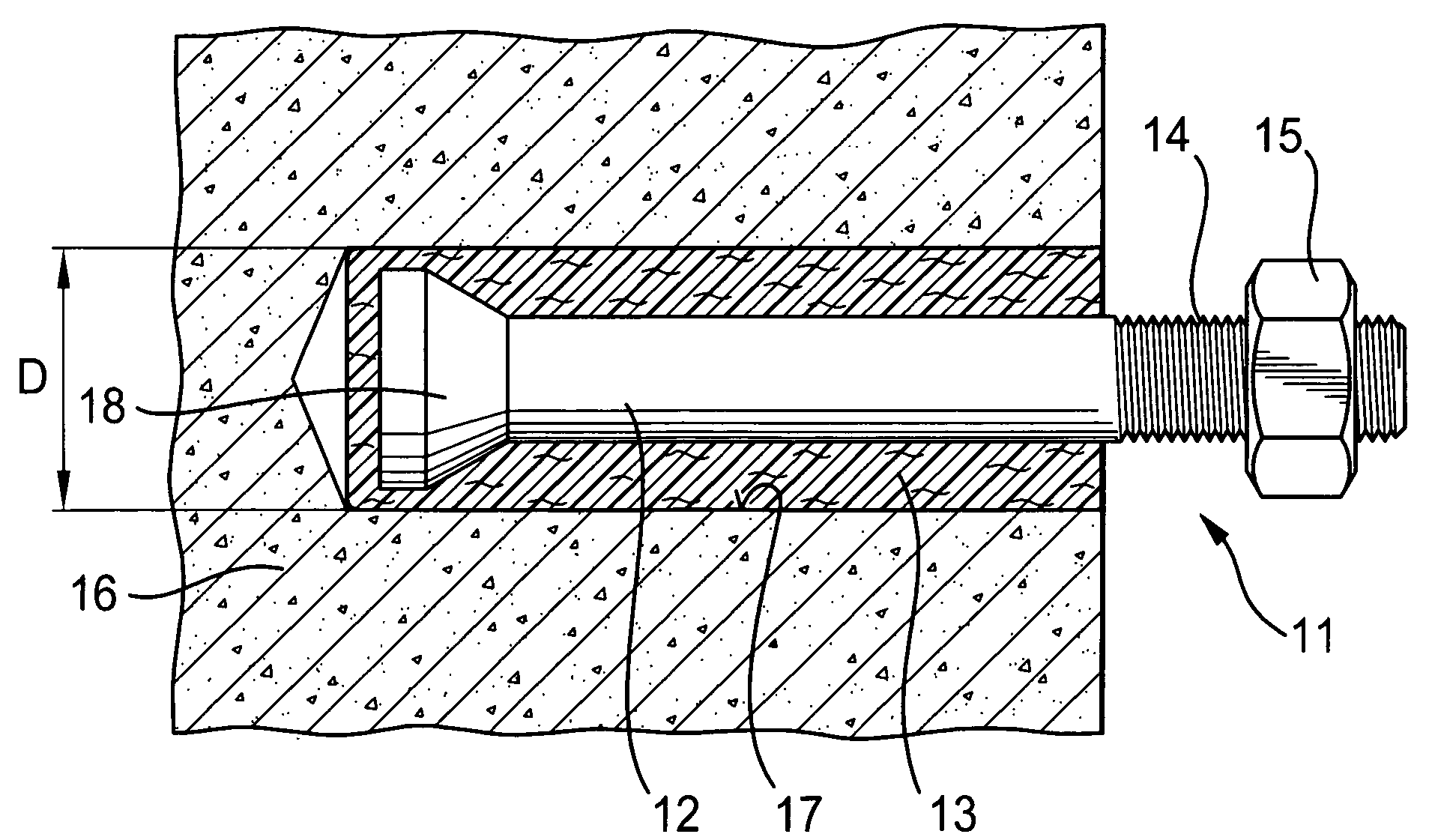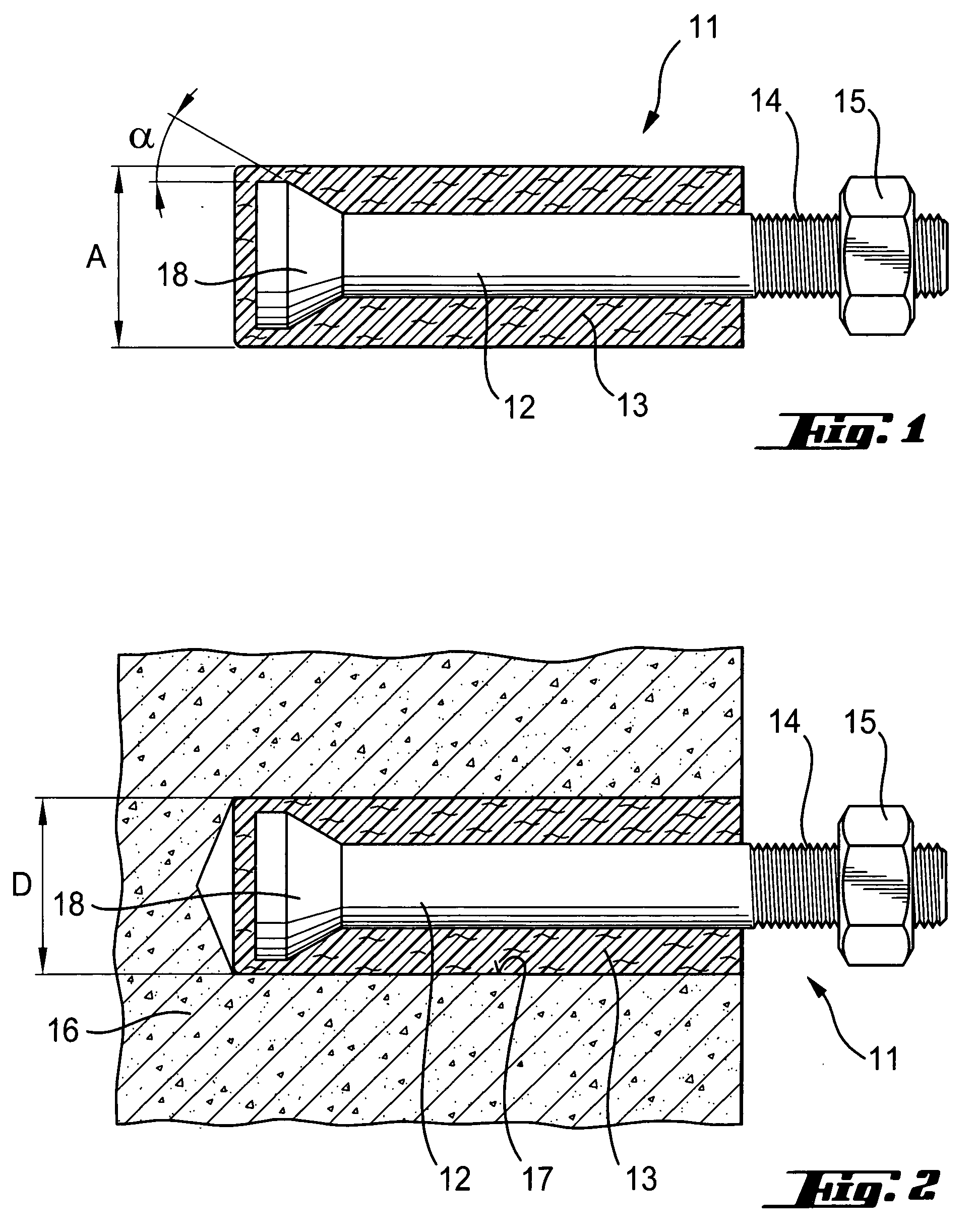Anchor element
a technology of anchor elements and anchors, applied in the direction of threaded fasteners, fastening devices, dowels, etc., can solve the problems of reducing the carrying capacity affecting the stability of the anchor element, and requiring considerable force, etc., to achieve the effect of simple setting
Inactive Publication Date: 2006-06-22
HILTI AG
View PDF7 Cites 20 Cited by
- Summary
- Abstract
- Description
- Claims
- Application Information
AI Technical Summary
Benefits of technology
[0013] It is the object of the present invention to provide an anchor element which overcomes the disadvantages mentioned above and, in particular, is simple to set and can be loaded immediately after setting. In addition, the load must be introduced substantially uniformly along the length of the bore.
[0018] Compared to conventional chemical anchor elements, it is possible to work with the anchor element according to the invention without drips even when fastening so-called overhead fittings in the ceiling area. Work safety is enhanced without taking special precautions and work can be performed neatly. Since there is no handling of chemical substances, there is a reduced risk of contamination and consequent discoloration in the area surrounding the bore hole as well as a reduced risk of incorrect setting. Further, it is not necessary to dispose of press-out devices and cartridges for the composite mortar. Compared to conventional expansion anchors or sleeve anchors, the load is introduced extensively homogeneously or extremely uniformly virtually over the entire length of the anchoring so that there are practically no local expansion forces, and it is therefore possible to realize small axial distances and edge distances. In addition, the anchor element according to the invention can be loaded immediately and there is no gap between the bore hole wall and the anchor part through which water or moisture can penetrate. Further, the anchor element according to the invention provides a fastening element which is economical to produce, requires a smaller setting depth for adequate anchoring than conventional expansion dowels or mechanical anchor elements, and can also be used in a cracked substrate.
[0019] The thermoplastic is preferably fiber-reinforced so that the mechanical properties, particularly the strength of the finished sleeve part, are improved over a thermoplastic without added fibers. For example, glass fibers or Kevlar® fibers are added to the thermoplastic. The thermoplastic can also be filled with a mineral, e.g., calcium carbonate, in order to improve its compressive strength in particular. The amount of the admixture contained in the thermoplastic is between 10 percent by weight and 50 percent by weight, preferably between 15 percent by weight an 40 percent by weight.
[0021] The thermoplastic is preferably a polyamide having a melting temperature that ensures a residual carrying capacity in case of fire. In addition, polyamides are resistant to alkaline metals and have excellent strength and toughness, particularly with regard to cold impact strength.
Problems solved by technology
The known solutions are disadvantageous in that a considerable expenditure of force is required for setting a screw anchor and the surrounding building material is damaged.
This known solution is disadvantageous in that these anchor elements introduce loads locally, at least in the region of the base of the bore, so that high stresses occur in this region leading to a sharply reduced carrying capacity in the set anchor element when the edge distances or axial distances of the anchor elements are small.
Further, an annular gap remains between the anchor element and the wall of the bore hole and water or moisture can penetrate therein and can cause corrosion particularly in metal anchor parts.
This known solution is disadvantageous in that the anchor element cannot be loaded after setting until the composite mortar has hardened, which can take from 1 hour to 24 hours depending on the circumstances such as the temperature of the substrate or of the environment.
This solution is disadvantageous in that the composite mortar is subject to an expiration date and can therefore be stored only under certain conditions.
This solution is disadvantageous in that it is necessary to prepare a cutout that is specifically adapted to this anchor element.
Method used
the structure of the environmentally friendly knitted fabric provided by the present invention; figure 2 Flow chart of the yarn wrapping machine for environmentally friendly knitted fabrics and storage devices; image 3 Is the parameter map of the yarn covering machine
View moreImage
Smart Image Click on the blue labels to locate them in the text.
Smart ImageViewing Examples
Examples
Experimental program
Comparison scheme
Effect test
example 1
[0030] The sleeve part is made of a polyamide 6 (PA 6) with 25 percent by weight of glass fibers.
example 2
[0031] The sleeve part is made of a polyamide 6.6 (PA 6.6) with 40 percent by weight of glass fibers.
[0032] The following is an example for a mineral-filled thermoplastic:
example 3
[0033] The sleeve part is made of a polypropylene (PP) with 20 percent by weight of calcium carbonate.
the structure of the environmentally friendly knitted fabric provided by the present invention; figure 2 Flow chart of the yarn wrapping machine for environmentally friendly knitted fabrics and storage devices; image 3 Is the parameter map of the yarn covering machine
Login to View More PUM
 Login to View More
Login to View More Abstract
An anchor element (11) has an anchor part (12), a sleeve part (13), and an expansion part (18) for expanding the sleeve part (13). The sleeve part (13) is secured to the anchor part (12) and is made of a thermoplastic.
Description
BACKGROUND OF THE INVENTION [0001] 1. Field of the Invention [0002] The present invention relates to an anchor element having anchor part, a sleeve part surrounding the anchor part, and an expansion part for expanding the sleeve part. [0003] 2. Description of the Prior Art [0004] Installations, e.g., in electrical and sanitation fields, and ceiling fixtures are fastened to substrates, e.g., walls and ceilings of a building, by anchor elements that are anchored in bores. For instance, screw anchors in the form of thread-cutting concrete screws which are screwed into a previously prepared bore are used for fastening in mineral substrates such as concrete or masonry. Screws are likewise used in organic substrates such as wood. The known solutions are disadvantageous in that a considerable expenditure of force is required for setting a screw anchor and the surrounding building material is damaged. Anchor elements, as they are called, are known for overcoming these disadvantages. [0005] ...
Claims
the structure of the environmentally friendly knitted fabric provided by the present invention; figure 2 Flow chart of the yarn wrapping machine for environmentally friendly knitted fabrics and storage devices; image 3 Is the parameter map of the yarn covering machine
Login to View More Application Information
Patent Timeline
 Login to View More
Login to View More Patent Type & Authority Applications(United States)
IPC IPC(8): F16B13/04
CPCF16B13/065F16B33/008
Inventor KUNZ, JAKOBROSENKRANZ, FALKGFELLER, BALZPICHELIN, FREDERICLEHMANN, MARIOGRAF, RENE
Owner HILTI AG
Features
- R&D
- Intellectual Property
- Life Sciences
- Materials
- Tech Scout
Why Patsnap Eureka
- Unparalleled Data Quality
- Higher Quality Content
- 60% Fewer Hallucinations
Social media
Patsnap Eureka Blog
Learn More Browse by: Latest US Patents, China's latest patents, Technical Efficacy Thesaurus, Application Domain, Technology Topic, Popular Technical Reports.
© 2025 PatSnap. All rights reserved.Legal|Privacy policy|Modern Slavery Act Transparency Statement|Sitemap|About US| Contact US: help@patsnap.com


